
50-60е
.pdf
H I G H H E E L S
“ I don’t know who invented the high heel, but all men owe him a lot.”
Marilyn Monroe
C H A P T E R 8
Completing the Look
Attention to detail makes a look. In the 1950s and 1960s, many of the clothes worn by ordinary people going about their daily lives were not so very different from many of the clothes worn today. This makes it especially important to get the accessories, hair, and makeup right since they will make a costume convincing.
Above: A turban, pearls, gloves, sunglasses and purse are used here to accessorize an elegant two-piece; typically of the era, make-up is bold and immaculate.
50
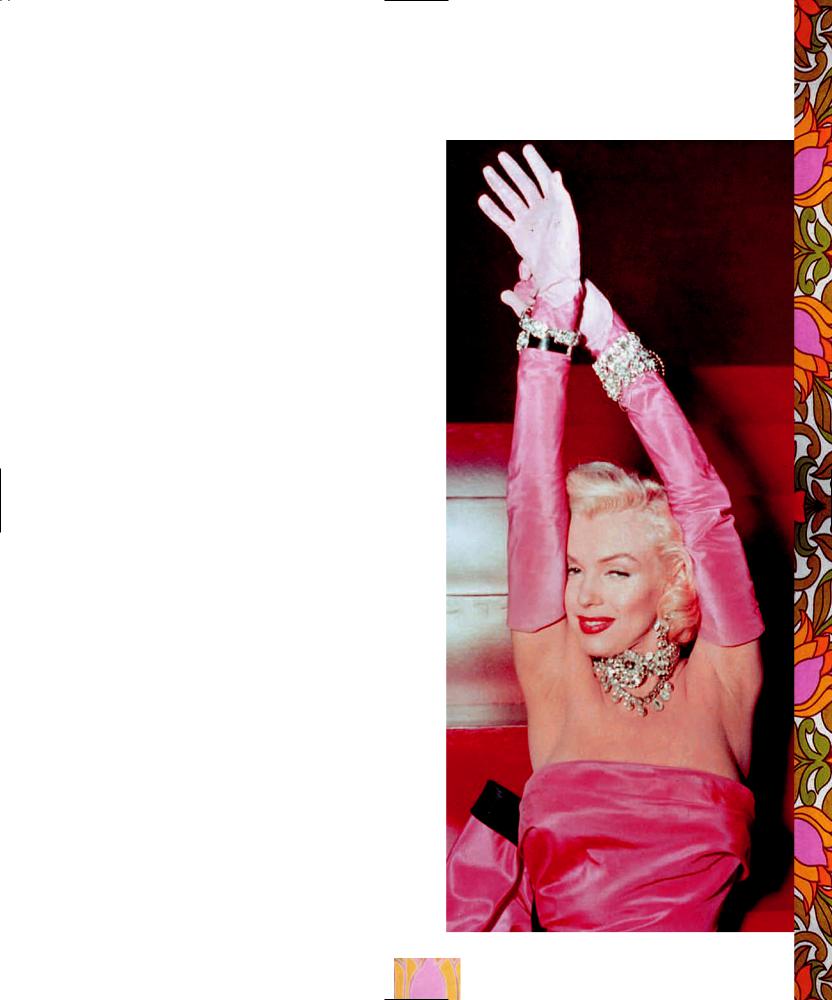
U N D E R N E A T H
In the 1950s, women held in their figures with corsets and girdles. The “roll on” was a stretch girdle that extended from the waist to partway down the thighs. To keep control of areas higher
up, a firm long-line bra held the bust in place and flattened any excess bulges between the bust and waist. Bras tended to have a conical, pointed shape.
During the 1960s, new fabrics and the less structured shape of clothes saw a move toward more flexible and comfortable underwear. Women still wore girdles, but the required body shape was flatter and more boyish. Men wore a simple tank top undershirt and baggy shorts or Y-front underpants.
H O S I E R Y
In the 1950s, pantyhose had not been invented—women wore stockings with garters. Stockings always had seams up the backs, and modern seamed pantyhose or stockings are still easy to find. With miniskirts, it was impossible to wear stockings and the newly designed pantyhose were essential. By the middle of the decade, pantyhose were available in thick and thin fabrics, with printed or woven patterns. Many similar styles are widely available today. Over-the-knee socks were also popular with miniskirts.
Men wore plain-colored socks, often held up with garters, during the 1950s. In the 1960s, new stretch fabrics allowed many men to abandon garters.
G L O V E S
In the 1950s, a woman was not properly dressed without gloves. Wealthier women owned many pairs of gloves, often in different colors to coordinate with different outfits. White or cream gloves were highly regarded. This was because keeping them clean required an investment in time (often the maid’s time) and therefore indicated that the gloves’ owner had money. Although leather gloves were popular, many women wore cotton or nylon gloves since they were cheaper. For evening wear, gloves were long and could even reach beyond the elbow. Today, white evening gloves can be dyed to match an outfit.
Below: Marilyn Monroe in 1950s
accessories— extravagant jewelry
over full-length evening gloves.
51
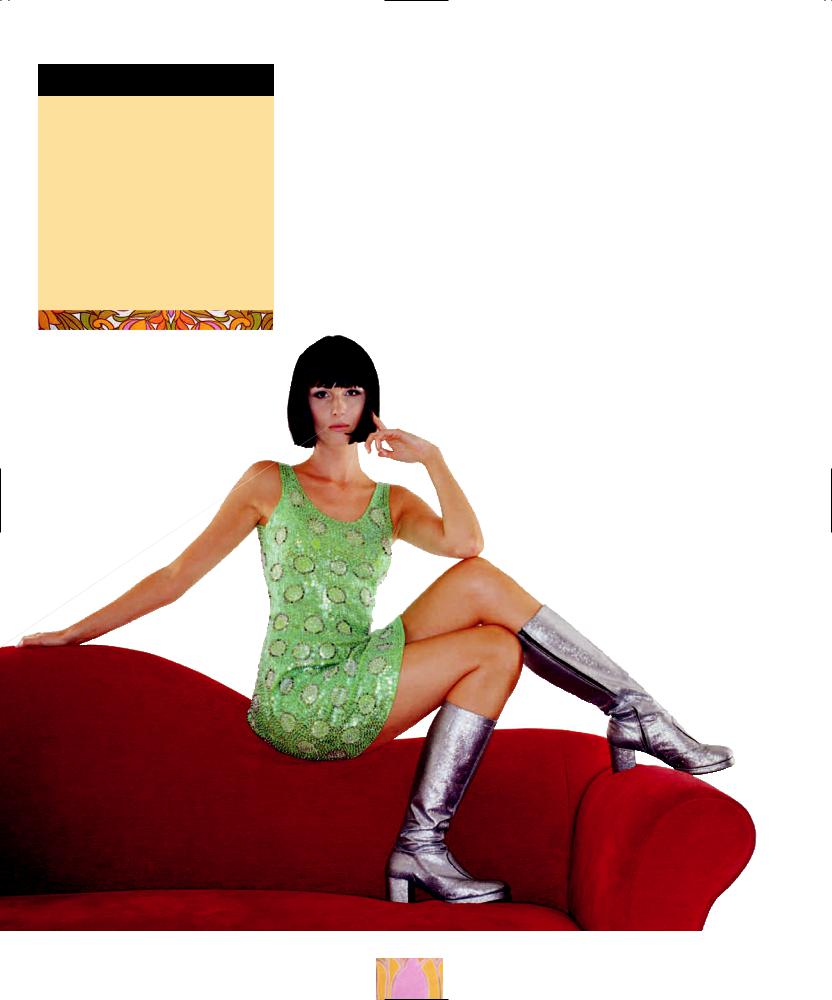
S T Y L E T I P
“Wet look” PVC was used for clothes and shoes. It had a very shiny surface that made it appear wet. You can achieve a wet look with many types of leather or plastic by adding a coat of high-gloss clear nail polish—but remember that you can’t remove it later!
Right: This fashion model from the
1960s wears long, zipped silver
boots with Cuban heels.
S H O E S
Shoes are a very important part of a look, particularly for women. Women’s shoes changed a lot between 1950 and 1969. During the 1950s, women’s shoes had a narrow heel and pointed toe. Slingbacks were popular. Heels were tapered and moderately high. Flat or low-heeled shoes, worn with slacks or for dancing, could be solid shoes or pointed slingbacks with a tiny heel.
The 1960s brought more variety to women’s shoes. Heels became lower or disappeared altogether. Toes were still pointed at the start of the decade, but later a square or rounded toe became popular. The big innovation was boots for women. There was a craze for white leather knee-length or mid-calf boots. Eventually, boots made from shiny plastic
even reached the thigh, ending just below the
52

like women’s—had a squarer, chunky heel and square toe. Alternative footwear toward the end of the 1960s included flat leather sandals or flip-flops, Doc Martens work boots, or just bare feet.
H A T S A N D H E A D G E A R
Women wore hats throughout the 1950s, often even indoors. Styles ranged from wide-brimmed “cartwheel” hats to flowerpot hats and cloches. Some had veils and called for even more pronounced makeup than usual so that the eyes and lips would remain prominent.
In the early 1960s, pillbox hats were popular. Later, berets, knitted or crocheted skullcaps, bubble-shaped toques, and caps were worn with tunics, shorts, and pants. When the “romantic” style took over, large floppy straw, raffia, or crocheted hats became fashionable.
Head scarves were popular in the 1950s and remained popular at least with older women in the 1960s. The scarf was folded into a triangle and knotted under the chin. Alternatively, a thin rectangular scarf could be wrapped around the head and neck.
Hippies sometimes wore a long scarf tied around the head like a headband or a triangular scarf tied over the hair with the knot at the back of the neck.
Men wore hats most of the time during the 1950s, often a fedora, although caps were popular leisure wear. Younger men began to go bareheaded in the 1960s. Baseball caps began to be worn as fashion items in the United States.
A C C E S S O R I E S
If a woman was to look properly dressed in the 1950s, her bag, shoes, belt, hat, and gloves needed to coordinate or match. As a result, a stylish woman had to have a large supply of accessories to go with all her outfits.
Right: First Lady, Jackie Kennedy, was a 1960s style icon. Here she wears a formal suit with matching pillbox hat, and gloves.
H AT C H E C K
“ Well, you look so pretty in it Honey, can I jump on it sometime? Yes, I just wanna see
If it’s really that expensive kind You know it balances on your head Just like a mattress balances
On a bottle of wine
Your brand new leopard-skin pillbox hat . . .”
Bob Dylan, Leopard-Skin Pill-
Box Hat (1966)
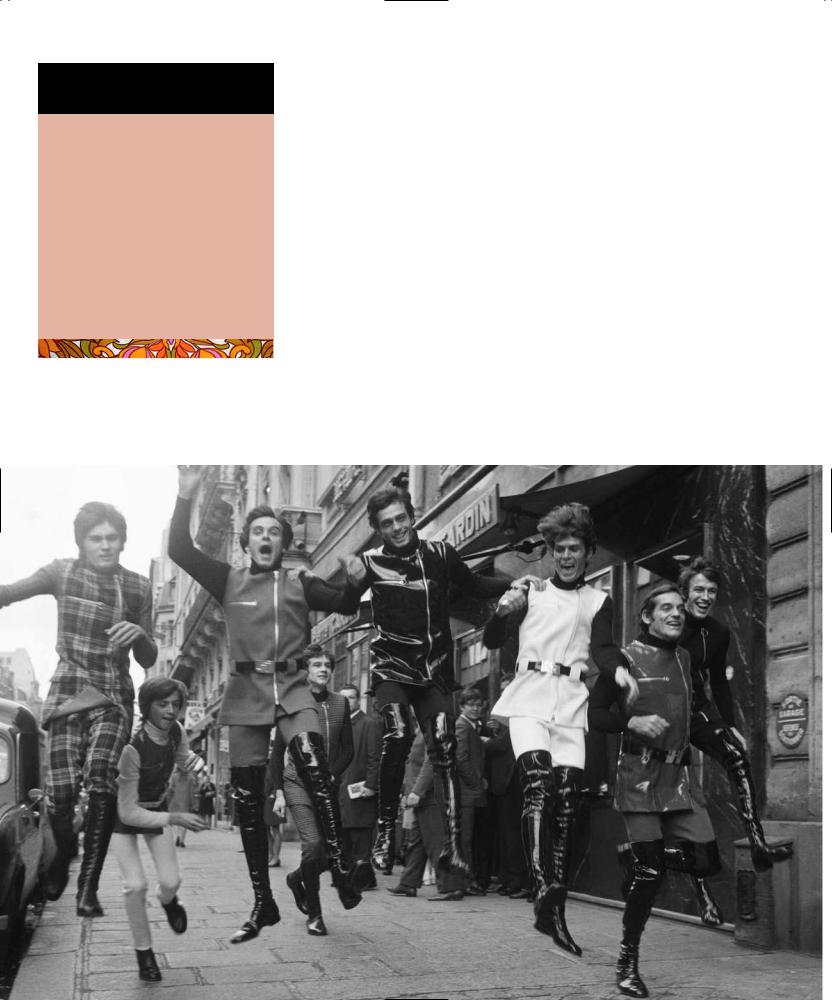
T O M O R R O W ’ S
W O R L D
“ The clothes that I prefer are those I invent for a life that doesn’t exist yet—the world of tomorrow.”
Fashion designer Pierre Cardin, whose 1960s men’s wear exploited new space-age materials such as vinyl, silver fabrics, and large zippers
Below: Cardin’s high-fashion extremes for men included wet-look thigh-high boots and belted tunics.
G L A S S E S A N D S U N G L A S S E S
Sunglasses became popular during the 1950s. At the same time, prescription glasses began to be designed rather than purely functional. The characteristic shape for women’s glasses in the 1950s had a heavy top frame, swept up at the outside corners.
During the 1960s, sunglasses with large frames in white or bright plastic and very dark lenses were in vogue. Later in the decade, hippie glasses had small, circular lenses with wire frames, a style popularized by John Lennon of the Beatles.
B A G S
In the 1950s, women always carried a purse. During the day, this would generally hang over the forearm and had a single strap. In the evening,
a smaller clutch purse was more common. Most purses were of leather or sometimes crocodile skin. A distinctive alternative was a box-like purse made of Lucite, a hard acrylic that could have a shiny, translucent, or opalescent look. New styles of purses in the 1960s included leather satchels and purses and shoulder bags made of bright PVC or shiny
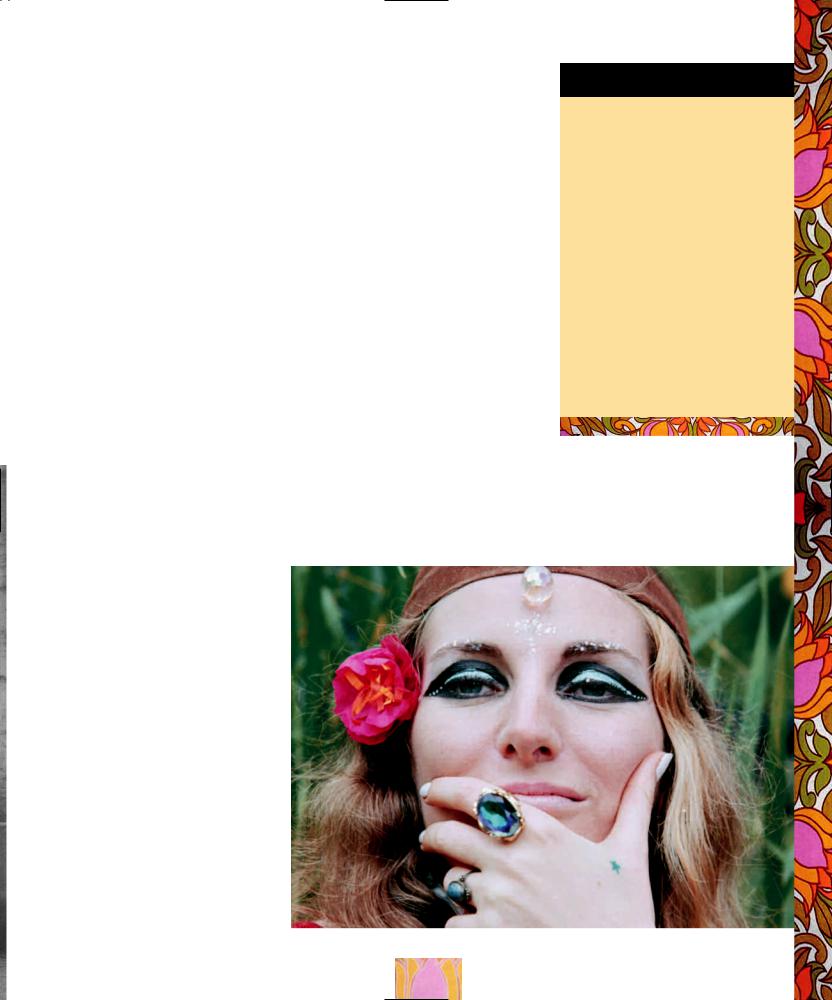
patent leather in different colors. White was popular. Hippies and romantics favored fabric shoulder bags or knitted, crocheted, or macramé bags made of yarn.
B E L T S
In the 1950s, with the accent on women’s waists, belts were naturally important accessories. Wide leather belts or belts in the same fabric as a woman’s dress or coat were the most popular. Belts were of a straightforward design, with a metal buckle. During the 1960s, more adventurous belts appeared. With the dropped waist, belts were sometimes worn much lower. A wide, shiny, patent leather or PVC belt, often in white, was commonly worn with hipster pants by both women and men. Chain belts, which hung on the hips rather than cinched the waist, were worn over knitted dresses and tunics or shifts. They could be made of metal links or oversized plastic rings. Later in the decade, the romantic and hippie looks made use of scarves around the waist or hips and woven, crocheted, or macramé belts, often decorated with beads and feathers.
M A K E U P
In the 1950s and 1960s, fashionable women had very distinctive styles of makeup. In the 1950s, the eyes and lips featured prominently. Eyes were lined with black and flicked up at the corner. Brows were prominent, drawn over with
eyebrow pencil. Eyelashes were accentuated, either with masses of mascara or with nylon false eyelashes. The skin was an even, pale tone. There was not yet any makeup formulated especially for black skin.
Women wore makeup whenever they went out of the house, though for many women the styles were not as exaggerated as those just described. They would wear rouge on their cheeks and lipstick on their mouths. Eye shadow in shades of blue and green was popular. Many
S T Y L E T I P
Smoking was not generally known to be dangerous in the 1950s, and only in the late 1960s did public awareness begin to change.
Smoking was considered a sign of sophistication, and many movie stars were photographed holding a cigarette. In the 1950s, women used long cigarette holders. Copies of cigarette holders and fake cigarettes are available from theatrical costumers and party stores.
Below: Very pronounced eye
makeup remained popular
throughout the 1960s; hippies
often added glitter or jewels.
55
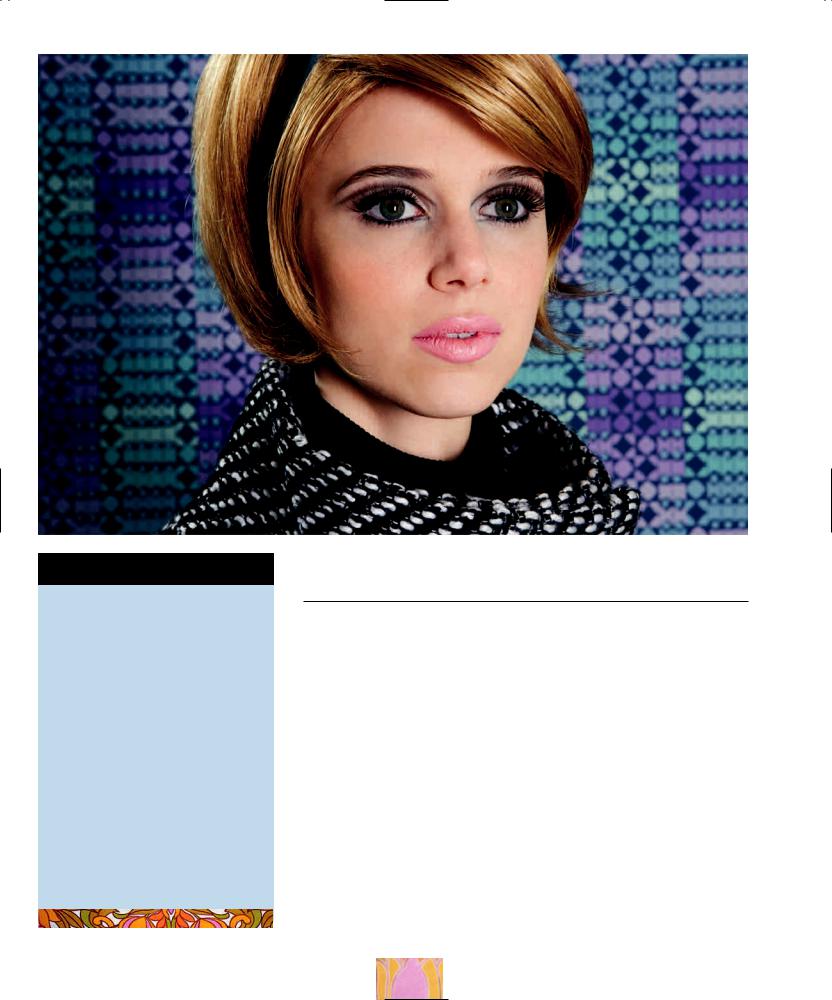
“ T H E L O O K ”
The addition of titanium to makeup in the 1960s made it possible to produce shimmering pale colors that soon came to be a defining feature of “the look” of the 1960s. Very pale lipsticks were worn, with heavy, dark eye makeup and white or very pale nail polish. The dark eyes with pale skin and lips produced a waif-like appearance popularized by icons such as Twiggy and Edie Sedgwick. Ostentatiously false eyelashes helped accentuate the eyes even more.
Above: “The look” in 1960s makeup: pale skin, pale lips, and prominent eyes
and brows.
women continued to wear this style through the 1960s. Nails were painted either red or pink.
During the 1960s, the colors of makeup changed considerably. Skin was still pale, but so now were lips and nails. Eyes were made up to be wide, with thick, dark lashes, and were often still dark-rimmed, but paler eye shadows were also beginning to be used.
W O M E N ’ S H A I R S T Y L E S
In the 1950s, women kept their hair neat and often hidden under a hat when out and about. Long hair was pinned up in a chignon. Young, fashionable women might cut their hair short in the “pixie cut” popularized by Audrey Hepburn. From the mid-1950s, a trend for high ponytails emerged among teenagers. Older women kept the short, permed styles they had worn during the 1940s, held firmly in place with hair spray.
56
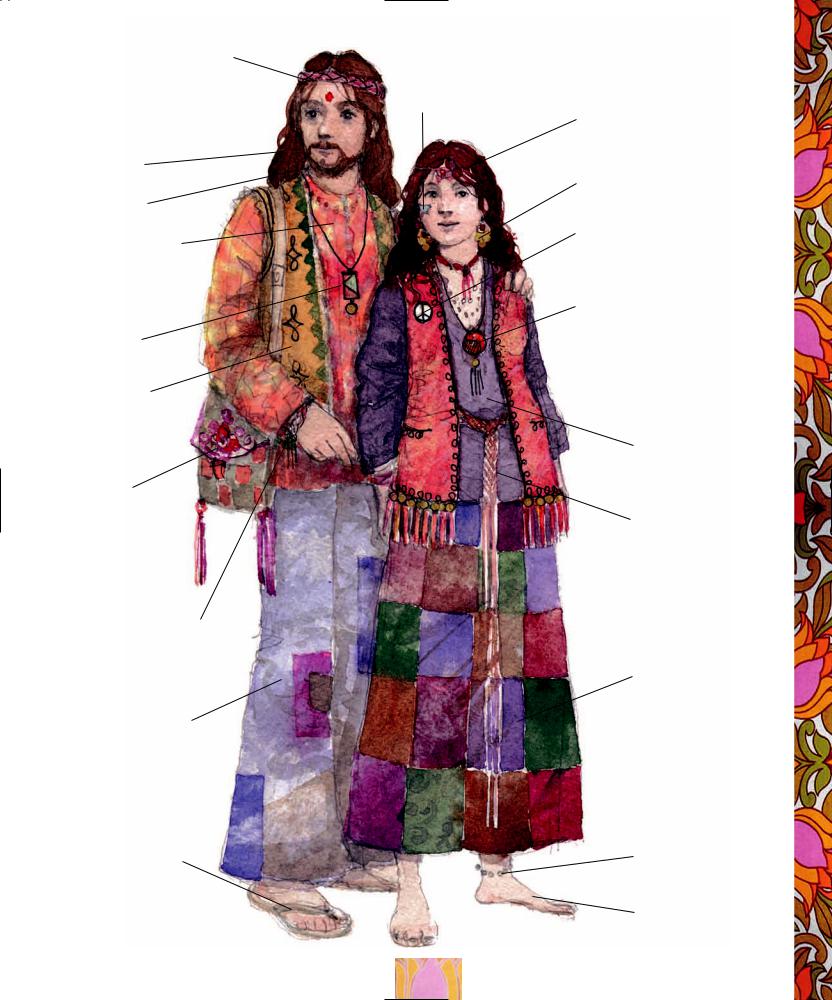
Band worn around head
Face painted with red  dot on forehead, based
dot on forehead, based
on Hindu tradition
Long hair
Facial hair
Collarless loose shirt made of cheesecloth or light cotton
Necklace
Sleeveless
Afghan vest
Leather shoulder bag with fringe
Braided hemp bracelet
Shabby, patched, widely flared bellbottoms
Flip-flops
1960s man and woman in hippie clothes
Face paint
Center-parted, long hair worn loose and unstyled
Ethnic jewelry
Button with political emblem
Pendant with yin-yang symbol
 Long, fringed, and beaded vest
Long, fringed, and beaded vest
Indian cotton shirt
Braided leather belt
Long patchwork skirt
Beaded anklet
Bare feet
57

B A C K - C O M B I N G A N D B E E H I V E S
Beehive hairdos appeared late in the 1950s. A girl started by backcombing sections of hair (brushing it down toward the head) so that it stuck up in tufts. Then she gently brushed a top layer of hair smooth over the top. She used her hands to roll the hair into a chignon and pinned it in place. Hair spray made the style rock solid and slightly glossy. The “do” was wrapped in a scarf before bed. A girl maintained her beehive for as long as she could since it was too difficult to refashion it every day.
In the 1960s, young women began to wear their hair loose. It was often cut to shoulder length, maybe held back with a head band, and frequently given volume by back-combing. A more spectacular style, which required hair to be at least shoulder length, was the beehive—a massive, cotton- candy-like construction of back-combed hair.
The geometric patterns popular in fabric design from the mid-1960s were echoed in geometric haircuts, which often took the form of sleek, asymmetric bobs. African-American women sometimes straightened their hair to achieve the look. Later in the decade, long, loose hair became popular, often given a pre-Raphaelite look by braiding while wet to go with the nostalgic long skirts and frilled blouses. Hippies also wore their hair long and sometimes adorned it with tiny plaits or braids decorated with colored yarn and beads.
Below: Set in 1962, the movie Hairspray (2007) was a riot of back-combed
hair and beehive hair styles.
58

M E N ’ S H A I R S T Y L E S
In the early 1950s, men wore their hair short and neat, cut above the ears. During the decade, hair became one of the identity badges of the different groups. One style popular with greasers and teddy boys was known as the DA (“duck’s arse”). To achieve this style, the hair was parted at the back and each side was rolled in toward the center parting. At the front, the hair stood up in a pompadour. To keep it in shape, the hair was slicked with Brylcreem, giving it a greasy look.
The Beatles’ “mop top” haircuts were at first seen as rebellious and untidily long, but hair soon became even longer. By the end of the decade, young men’s hair often curled onto their shirt collars and beyond and was cut with as much care and attention as women’s.
“Afro” hair was hair grown long and left to curl naturally so that it produced a mop of hair standing out from the head in all directions. It became a symbol of African-American pride.
Above: 1950s hairstyles in the
movie Grease (1978).
FA C I A L H A I R
Most men remained clean-shaven, but goatee beards and droopy mustaches became popular among the beat generation. Hippies allowed hair on their heads and faces to grow without restraint, and many hippies had a full beard as well as long hair.
59
